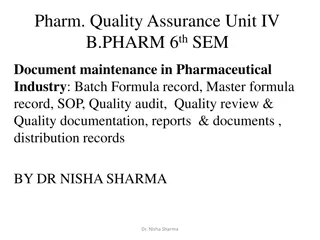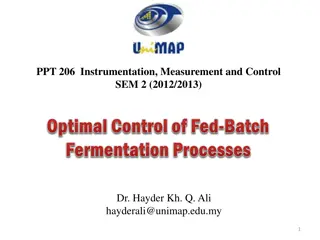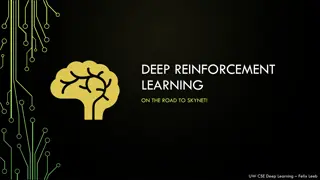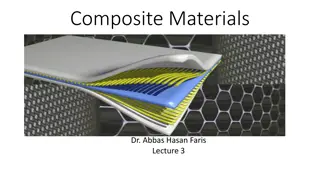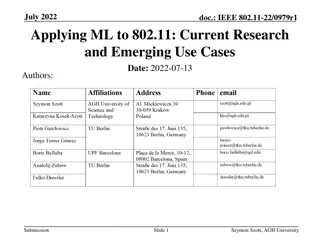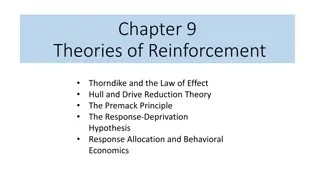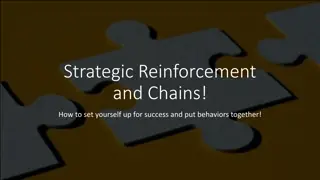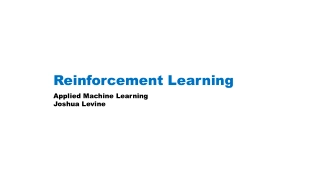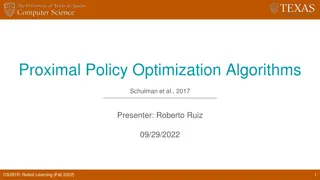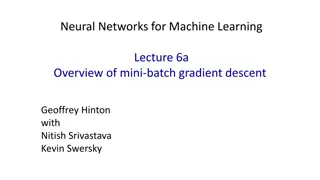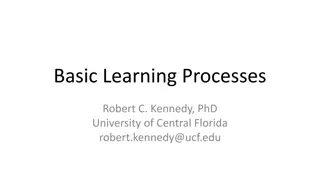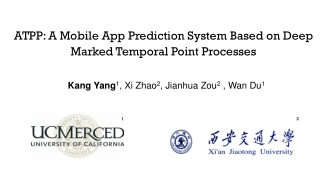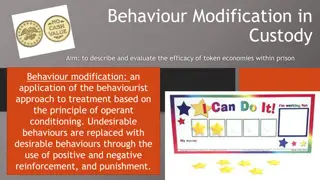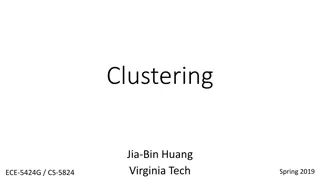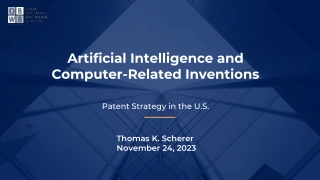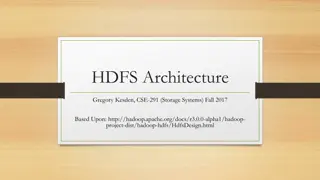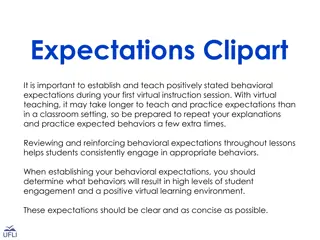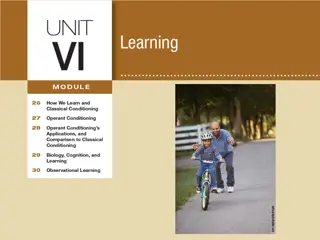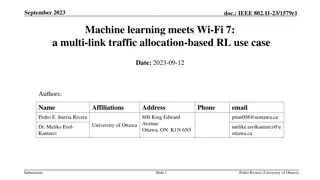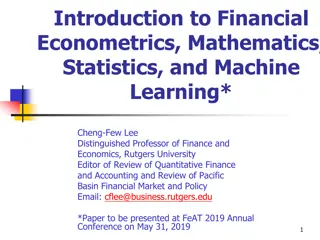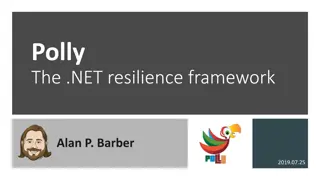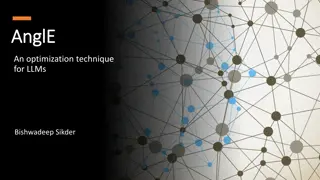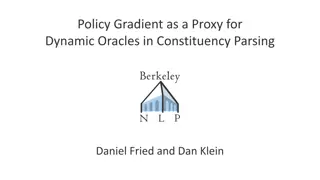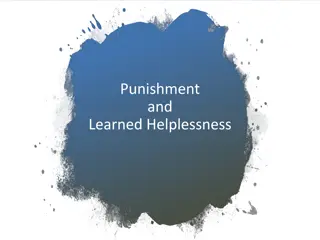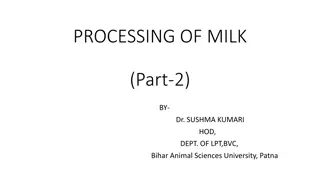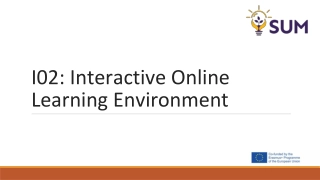Batch Reinforcement Learning: Overview and Applications
Batch reinforcement learning decouples data collection and optimization, making it data-efficient and stable. It is contrasted with online reinforcement learning, highlighting the benefits of using a fixed set of experience to optimize policies. Applications of batch RL include medical treatment optimization, emergency response strategies, and online educational system tuning. Least Squares Policy Iteration (LSPI) is introduced as a model-free batch RL algorithm that learns a linear approximation of the Q-function. The algorithm is stable, efficient, and can be applied to datasets regardless of how they were collected.
Download Presentation

Please find below an Image/Link to download the presentation.
The content on the website is provided AS IS for your information and personal use only. It may not be sold, licensed, or shared on other websites without obtaining consent from the author. Download presentation by click this link. If you encounter any issues during the download, it is possible that the publisher has removed the file from their server.
E N D
Presentation Transcript
Batch Reinforcement Learning Alan Fern * Based in part on slides by Ronald Parr
Overview What is batch reinforcement learning? Least Squares Policy Iteration Fitted Q-iteration Batch DQN
Online versus Batch RL Online RL: integrates data collection and optimization Select actions in environment and at the same time update parameters based on each observed (s,a,s ,r) Batch RL: decouples data collection and optimization First generate/collect experience in the environment giving a data set of state-action-reward-state pairs {(si,ai,ri,si )} We may not even know where the data came from Use the fixed set of experience to optimize/learn a policy Online vs. Batch: Batch algorithms are often more data efficient and stable Batch algorithms ignore the exploration-exploitation problem, and do their best with the data they have
Batch RL Motivation There are many applications that naturally fit the batch RL model Medical Treatment Optimization: Input: collection of treatment episodes for an ailment giving sequence of observations and actions including outcomes Ouput: a treatment policy, ideally better than current practice Emergency Response Optimization: Input: collection of emergency response episodes giving movement of emergency resources before, during, and after 911 calls Output: emergency response policy
Batch RL Motivation Online Education Optimization: Input: collection of episodes of students interacting with an educational system that gives information and questions in order to teach a topic Actions correspond to giving the student some information or giving them a question of a particular difficulty and topic Ouput: a teaching policy that is tuned to student based on what is known about the student
Least Squares Policy Iteration (LSPI) LSPI is a model-free batch RL algorithm Learns a linear approximation of Q-function stable and efficient Never diverges or gives meaningless answers LSPI can be applied to a dataset regardless of how it was collected But garbage in, garbage out. Least-Squares Policy Iteration, Michail Lagoudakis and Ronald Parr, Journal of Machine Learning Research (JMLR), Vol. 4, 2003, pp. 1107-1149.
Least Squares Policy iteration No time to cover details of derivation Details are in the appendix of these slides LSPI is a wrapper around an algorithm LSTDQ LSTDQ: learns a Q-function for current policy given the batch of data Can learn Q-function for policy from any (reasonable) set of samples---sometimes called an off-policy method No need to collect samples from current policy Disconnects policy evaluation from data collection Permits reuse of data across iterations! Truly a batch method.
Implementing LSTDQ LSTDQ uses a linear Q-function with features ?? and weights ??. w a s Q ) , ( = ( , ) w s a k k k ( = ) arg max ( , ) s Q s a defines greedy policy: w a w For each (s,a,r,s ) sample in data set: + + b B w ( , ) ( , ) ( , ) ( , ' s ( ' )) B B s a s a s a s ij ij i j i j w ( a s , ) b b r i i i arg max ( , ' s ) Qw a 1 a
Running LSPI There is a Matlab implementation available! 1. Collect a database of (s,a,r,s ) experiences (this is the magic step) 2. Start with random weights (= random policy) 3. Repeat Evaluate current policy against database Run LSTDQ to generate new set of weights New weights imply new Q-function and hence new policy Replace current weights with new weights Until convergence
Results: Bicycle Riding Watch random controller operate simulated bike Collect ~40,000 (s,a,r,s ) samples Pick 20 simple feature functions ( 5 actions) Make 5-10 passes over data (PI steps) Reward was based on distance to goal + goal achievement Result: Controller that balances and rides to goal
What about Q-learning? Ran Q-learning with same features Used experience replay for data efficiency
Some key points LSPI is a batch RL algorithm Can generate trajectory data anyway you want Induces a policy based on global optimization over full dataset Very stable with no parameters that need tweaking
So, whats the bad news? LSPI does not address the exploration problem It decouples data collection from policy optimization This is often not a major issue, but can be in some cases k2 can sometimes be big Lots of storage Matrix inversion can be expensive Bicycle needed shaping rewards Still haven t solved Feature selection (issue for all machine learning, but RL seems even more sensitive)
Fitted Q-Iteration LSPI is limited to linear functions over a given set of features Fitted Q-Iteration allows us to use any type of function approximator for the Q-function Random Forests have been popular Deep Networks Fitted Q-Iteration is a very straightforward batch version of Q-learning Damien Ernst, Pierre Geurts, Louis Wehenkel. (2005). Tree-Based Batch Mode Reinforcement Learning Journal of Machine Learning Research; 6(Apr):503 556.
Fitted Q-Iteration Let ? = } be our batch of transitions 1. ??,??,??,?? Initialize approximate Q-function ?? (perhaps weights of a deep network) 2. Initialize training set ? = For each ??,??,??,?? ??= (??+ max Add training example ??,??, ?? to T Learn new ?? from training data ? Goto 3 3. ? ???? 4. ,? // new estimate of ? ??,?? ? 5. 6. Step 5 could use any regression algorithm: neural network, random forests, support vector regression, Gaussian Process
DQN DQN was developed by DeepMind originally for online learning of Atari games However, the algorithm can be used effectively as is for Batch RL. I haven t seen this done, but it is straightforward.
DQN for Batch RL Let ? = } be our batch of transitions 1. ??,??,??,?? Initialize neural network parameter values to ? Randomly sample a mini-batch of ? transition { ??,??,??,?? from ? 2. } 3. Perform a TD update for each parameter based on mini-batch ???? 4. ,? ????,?? ? ? + ? ??+ max ??? ??,?? ? ? Goto 3 5.
Appendix 21
Projection Approach to Approximation Recall the standard Bellman equation: = max ) ( a s V + * * ( , ) ( | ' s , ) ( ) ' s R s a P s a V ' s V = * * [ ] T V or equivalently where T[.] is the Bellman operator Recall from value iteration, the sub-optimality of a value function can be bounded in terms of the Bellman error: [V T V ] This motivates trying to find an approximate value function with small Bellman error
Projection Approach to Approximation Suppose that we have a space of representable value functions E.g. the space of linear functions over given features Let be a projection operator for that space Projects any value function (in or outside of the space) to closest value function in the space Fixed Point Bellman Equation with approximation ( [ V T V = ) ] * * Depending on space this will have a small Bellman error LSPI will attempt to arrive at such a value function Assumes linear approximation and least-squares projection
Projected Value Iteration Na ve Idea: try computing projected fixed point using VI Exact VI: (iterate Bellman backups) + = 1 i i [ ] V T V Projected VI: (iterated projected Bellman backups): ( V = ) ] + 1 i i [ T V Projects exact Bellman backup to closest function in our restricted function space exact Bellman backup (produced value function)
Example: Projected Bellman Backup Restrict space to linear functions over a single feature : ) ( w s V = ( ) s (s1)=1, (s2)=2 Suppose just two states s1 and s2 with: Suppose exact backup of Vi gives: [ V T = = i i ]( ) , 2 [ ]( ) 2 s T V s 1 2 Can we represent this exact backup in our linear space? No (s1)=1 (s2)=2
Example: Projected Bellman Backup Restrict space to linear functions over a single feature : ) ( w s V = ( ) s (s1)=1, (s2)=2 Suppose just two states s1 and s2 with: Suppose exact backup of Vi gives: [ V T = = i i ]( ) , 2 [ ]( ) 2 s T V s 1 2 The backup can t be represented via our linear function: + . 1 = 1 Vi ( ) ] ( ) 333 ( ) s s + = 1 i i [ V T V projected backup is just least-squares fit to exact backup (s1)=1 (s2)=2
Problem: Stability Exact value iteration stability ensured by contraction property of Bellman backups: + = 1 i i [ ] V T V Is the projected Bellman backup a contraction: ( [ V T V = ) ] + 1 i i ?
Example: Stability Problem [Bertsekas & Tsitsiklis 1996] Problem: Most projections lead to backups that are not contractions and unstable s1 s2 Rewards all zero, single action, = 0.9: V* = 0 Consider linear approx. w/ single feature with weight w. ( s w s V = Optimal w = 0 since V*=0 ) ( )
Example: Stability Problem weight value at iteration i (s1)=1 Vi(s1) = wi (s2)=2 Vi(s2) = 2wi s1 s2 From Vi perform projected backup for each state i i s V s V T 8 . 1 ) ( ) ]( [ 2 1 = = ) ]( [ 2 2 = = i w i i i ( ) 8 . 1 T V s V s w Can t be represented in our space so find wi+1 that gives least-squares approx. to exact backup After some math we can get: wi+1 = 1.2 wi What does this mean?
Example: Stability Problem 3 V 2 V V(x) Iteration # 1 V 0 V 1 2 S Each iteration of Bellman backup makes approximation worse! Even for this trivial problem projected VI diverges.
Understanding the Problem What went wrong? Exact Bellman backups reduces error in max-norm Least squares (= projection) non-expansive in L2 norm But may increase max-norm distance! Conclusion: Alternating Bellman backups and projection is risky business
OK, Whats LSTD? Approximates value function of policy ? given trajectories of ? Assumes linear approximation of ?? denoted ? s V ) ( = ( ) w s k k k The k are arbitrary feature functions of states Some vector notation w ( V (1 s ) ) s 1 k 1 = = = w = V k 1 K ( V ( ) s ) ns w k n k
Deriving LSTD = V w assigns a value to every state V is a linear function in the column space of 1 k, that is, w V + = 1 1 K basis functions 1(s1) 2(s1)... 1(s2) 2(s2) + w K K = # states . . .
Suppose we know true value of policy = V w V We would like the following: Least squares weights minimizes squared error w = ( 1 T T ) V Sometimes called pseudoinverse Least squares projection is then w V = = 1 T T ( ) V Textbook least squares projection operator
But we dont know V Recall fixed-point equation for policies = ( ) ( s R s V + , ( )) ( | ' s , ( )) ( ) ' s s P s s V ' s Will solve a projected fixed-point equation: ( R V + = ) V P ( , ( )) ( | , ( )) ( | , ( )) R s s P s s s P s s s 1 1 1 1 1 1 1 n = = , R P ( , ( )) ( | , ( )) ( | , ( )) R s s P s s s P s s s 1 1 n n n n n n Substituting least squares projection into this gives: w = ( ( ) + 1 T T ) R P w 1 = T T T ( ) w P R Solving for w:
Almost there 1 = T T T ( ) w P R Matrix to invert is only K x K But Expensive to construct matrix (e.g. P is |S|x|S|) Presumably we are using LSPI because |S| is enormous We don t know P We don t know R
Using Samples for Suppose we have state transition samples of the policy running in the MDP: {(si,ai,ri,si )} Idea: Replace enumeration of states with sampled states K basis functions 1(s1) 2(s1)... 1(s2) 2(s2) = = states samples . . .
Using Samples for R Suppose we have state transition samples of the policy running in the MDP: {(si,ai,ri,si )} Idea: Replace enumeration of reward with sampled rewards r1 r2 samples R = . . .
Using Samples for P Idea: Replace expectation over next states with sampled next states. K basis functions 1(s1 ) 2(s1 )... 1(s2 ) 2(s2 ) P . s from (s,a,r,s ) . .
Putting it Together LSTD needs to compute: w ( = = B b = = 1 1 T T T ) P R B b R ( P T T ) T from previous slide The hard part of which is B the kxk matrix: Both B and b can be computed incrementally for each (s,a,r,s ) sample: (initialize to zero) B B ij ij + r b b i i + ( ) ( ) ( ) ( ) ' s s s s i j ) i j (s i
LSTD Algorithm Collect data by executing trajectories of current policy For each (s,a,r,s ) sample: B B ij b b i i + ( ) ( ) ( ) ( ) ' s s s s ij + i j i j ( a s , ) r i 1 w B b
LSTD Summary Does O(k2) work per datum Linear in amount of data. Approaches model-based answer in limit Finding fixed point requires inverting matrix Fixed point almost always exists Stable; efficient
Approximate Policy Iteration with LSTD Policy Iteration: iterates between policy improvement and policy evaluation Idea: use LSTD for approximate policy evaluation in PI Start with random weights w (i.e. value function) Repeat Until Convergence = greedy( ) // policy improvement , s V ( (s ) w ) Evaluate using LSTD Generate sample trajectories of Use LSTD to produce new weights w (w gives an approx. value function of )
What Breaks? No way to execute greedy policy without a model Approximation is biased by current policy We only approximate values of states we see when executing the current policy LSTD is a weighted approximation toward those states Can result in Learn-forget cycle of policy iteration Drive off the road; learn that it s bad New policy never does this; forgets that it s bad Not truly a batch method Data must be collected from current policy for LSTD
LSPI LSPI is similar to previous loop but replaces LSTD with a new algorithm LSTDQ LSTD: produces a value function Requires samples from policy under consideration LSTDQ: produces a Q-function for current policy Can learn Q-function for policy from any (reasonable) set of samples---sometimes called an off-policy method No need to collect samples from current policy Disconnects policy evaluation from data collection Permits reuse of data across iterations! Truly a batch method.


